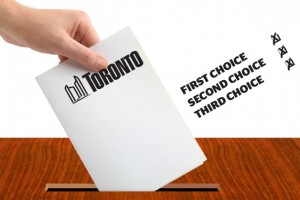Something good happened at Toronto City Hall this week.
I know, I know. I’m as surprised as you are.
Councillors vote to seek end of ‘first past the post’ system in city elections
Toronto city council took a significant step on Tuesday towards dramatically changing how the city elects its leaders — and who gets to cast a ballot.
By a vote of 26 to 15, the governing body asked the provincial government to allow it to use the ranked choice voting system, which demands that the winning candidate accumulate at least 50% of votes cast. It also asked, by a margin of 21 to 20, the minister of municipal affairs and housing to grant permanent residents the right to vote in municipal elections. Both initiatives require Queen’s Park to amend legislation.
Proportional representation crusaders will lament that this is more about refining first past the post than overhauling the system, but it’s for that very reason these reforms are likely to see the light of day. Like the weather, Canadians love to complain about our dysfunctional political system, but nobody ever seems to do anything about it. Over the past decade, Canadians have voted down STV, MMP, and various other acronymed voting systems in four provincial referenda. There simply doesn’t appear to be an appetite in the country for radical electoral reform.
That’s what makes the preferential ballot so appealing. It’s simple – you rank the candidates in order, something most voters do in their heads anyways. The candidate with the most votes still wins – the only difference is that sometimes the vote total will include second and third place votes. Although that sounds like a largely insignificant change, it should lead to a few tangible benefits.
First, it ensures the winner better reflects the will of the people. With first past the post, all it takes is a 3-way race for someone to get elected with under 40% of the vote – Nathan Phillips, for whom the square outside City Hall is named, won his first election as Mayor of Toronto with just 34% support. While I’m sure that election wasn’t on the minds of councillors, many were no doubt imagining a hypothetical scenario where 2 or 3 strong candidates split the “anti-crack” vote, leading to Rob Ford’s re-election. No, these changes won’t take effect next year, but having a not-so-hypothetical hypothetical staring us in the face certainly makes the benefits of this system easier to grasp.
With the dreaded “vote split” no longer an issue, candidates can step forward without being accused of siphoning votes away from the frontrunners, and voters will no longer have to choose between the candidate they like and the most “strategic” choice. I’m sure Joe Pantalone would have rather spent the last week of the 2010 Mayoral Campaign talking about the issues rather than if he was going to drop out to prevent a vote split on the left. Ditto for every single candidate who has ever run with good ideas but little chance of winning.
Finally, a ranked ballot should lead to more civility on the campaign trail. To be realistic, it won’t mean a lot more civility, but maybe a little bit. Candidates will need to be careful about alienating second and third choice voters by waging an overly negative campaign. Yes, the two frontrunners will still knock heads, but in a 3 or 4-person race the game becomes more about being everyone’s second choice than about depressing the other guy’s turnout.
The ranked ballot isn’t a radical change, and its impact will not be dramatic. But voters aren’t looking for radical change, and it will make our political system a little bit better. Given the state of municipal politics in Toronto these days, that’s very welcome.

3 responses to “As Easy As 1-2-3”
Cool news!; I hope Queen’s Park will grant this. When will Trees Standing In Water, along with other municipalities, be able to make more of these decisions on their own?
I’m a supporter of the ranked ballot and think it’s not merely a compromise but a far more appealing reform than proportional representation. It preserves the many desirable aspects of our current system while eliminating the problem of broadly unpopular candidates winning with a relatively small percentage of the total vote. It encourages voters to decide for themselves how they want to compromise to produce a government that appeals to a sufficiently broad spectrum of the electorate instead of retreating into small single-issue parties. Proportional representation places enormous power in the hands of the leader who selects the list of candidates and forces backroom coalition negotiations rather than genuine open electoral competition.
I quite agree, PR is a big step down in my opinion, but ranked votes are a good or at least an interesting move. Rather than try to have a hard core of votes you need to appeal the the party next to you. Alberta Tories choose this way, so in effect the Alberta Premier gets chosen like that. The two dogs in the fight after Ralph stepped down lost out to the third place Stelmach who got the second choice votes of both front runners.
Admittedly, Stelmach was a terrible Premier who’s ‘nice guys can win’ lack of actual principles translated into fun things like high spending, raising the min wage as people were losing jobs in the downturn, and staunchly defending the human rights ruling that banned a pastor from even emailing about gay marriage in a decision even a gay rights group criticized so admittedly he was most likely the worst choice and I greatly regret giving him my second choice.
But, that might be more the fault of the other two for not understanding how the voting changed the dynamic more than the system itself.